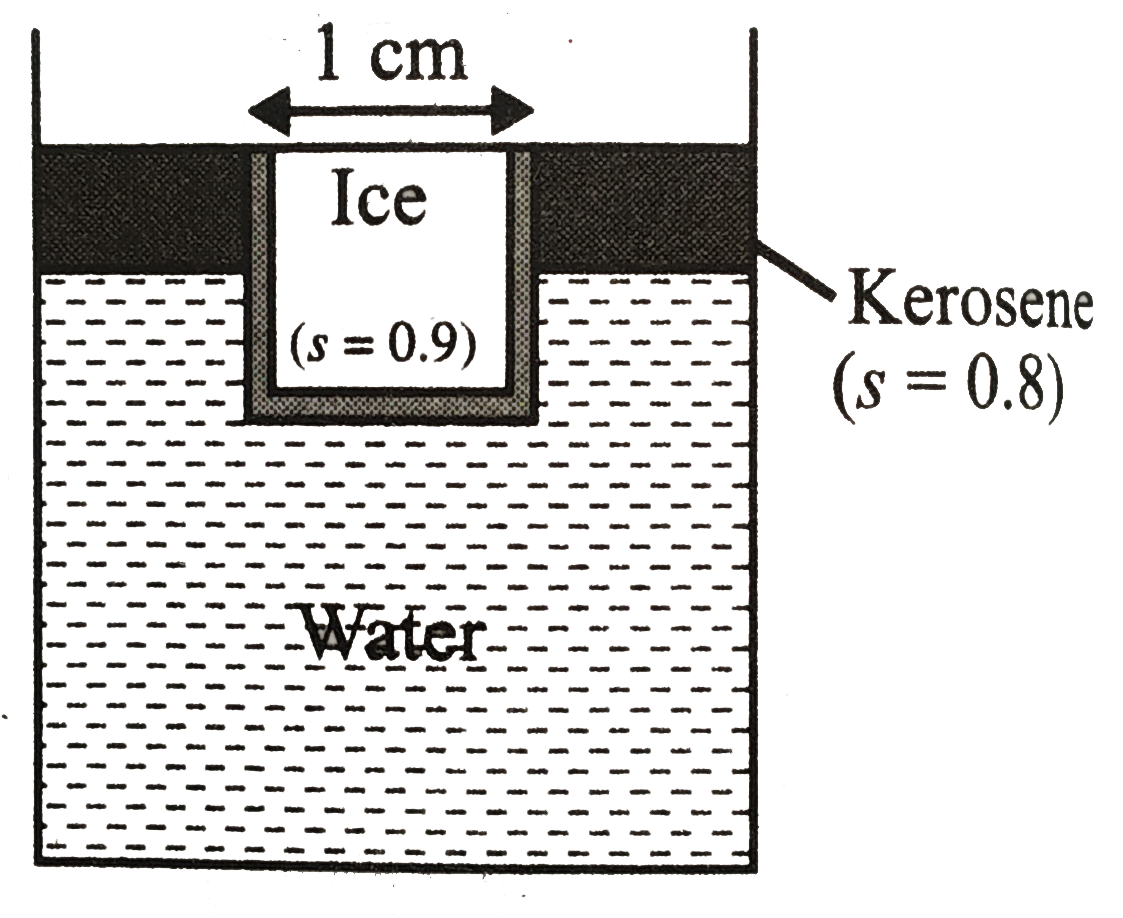An ice cube of size a=10cm is floating in a tank (base area A=50cm×50cm) partially filled with water. The change in gravitational potential energy, when ice melts completely is (density of ice is 900kg/m2)
−0.072J
−0.24J
−0.016J
−0.045J
The correct Answer is:D
To solve the problem of finding the change in gravitational potential energy when an ice cube melts completely, we can follow these steps:
Step 1: Calculate the Volume of the Ice Cube
The volume V of the ice cube can be calculated using the formula for the volume of a cube:
V=a3
Given that the size of the ice cube a=10cm=0.1m:
V=(0.1)3=0.001m3
Step 2: Calculate the Mass of the Ice Cube
Using the density of ice, we can find the mass m of the ice cube:
m=density×V
Given that the density of ice is 900kg/m3:
m=900kg/m3×0.001m3=0.9kg
Step 3: Determine the Volume of Water Produced by Melting Ice
When the ice melts, it turns into water. The volume of water Vw produced can be calculated using the density of water, which is approximately 1000kg/m3:
Vw=mdensity of water=0.9kg1000kg/m3=0.0009m3
Step 4: Calculate the Excess Volume of the Ice Cube Above Water Level
The excess volume Ve of the ice cube that was above the water level before melting can be calculated as:
Ve=V−Vw=0.001m3−0.0009m3=0.0001m3
Step 5: Calculate the Height of the Excess Volume
The height h of the excess volume can be calculated using the base area A of the tank:
h=VeA
The base area A=50cm×50cm=0.25m2:
h=0.0001m30.25m2=0.0004m=0.04cm
Step 6: Calculate the Change in Gravitational Potential Energy
The change in gravitational potential energy ΔPE when the ice melts can be calculated using the formula:
ΔPE=ρ⋅g⋅h⋅Ve
Where:
- ρ is the density of water (1000kg/m3)
- g is the acceleration due to gravity (9.8m/s2)
- h is the height of the excess volume
- Ve is the excess volume
Substituting the values:
ΔPE=1000kg/m3⋅9.8m/s2⋅0.0001m3
ΔPE=0.98J
Since the ice cube is floating and the potential energy decreases when it melts, we represent this change as negative:
ΔPE=−0.98J
Final Answer
The change in gravitational potential energy when the ice melts completely is −0.98J.
---
The volume V of the ice cube can be calculated using the formula for the volume of a cube:
Using the density of ice, we can find the mass m of the ice cube:
When the ice melts, it turns into water. The volume of water Vw produced can be calculated using the density of water, which is approximately 1000kg/m3:
The excess volume Ve of the ice cube that was above the water level before melting can be calculated as:
The height h of the excess volume can be calculated using the base area A of the tank:
The change in gravitational potential energy ΔPE when the ice melts can be calculated using the formula:
- ρ is the density of water (1000kg/m3)
- g is the acceleration due to gravity (9.8m/s2)
- h is the height of the excess volume
- Ve is the excess volume
The change in gravitational potential energy when the ice melts completely is −0.98J.
Topper's Solved these Questions
- PROPERTIES OF MATTERBOOK - DC PANDEY ENGLISHCHAPTER - PROPERTIES OF MATTEREXERCISE - More than one option is correct
21 Videos
- PROPERTIES OF MATTERBOOK - DC PANDEY ENGLISHCHAPTER - PROPERTIES OF MATTEREXERCISE - Comprehension
32 Videos
- PROPERTIES OF MATTERBOOK - DC PANDEY ENGLISHCHAPTER - PROPERTIES OF MATTEREXERCISE - Integer
8 Videos
- PROJECTILE MOTIONBOOK - DC PANDEY ENGLISHCHAPTER - PROJECTILE MOTIONEXERCISE - Level - 2 Subjective
10 Videos
- RAY OPTICSBOOK - DC PANDEY ENGLISHCHAPTER - RAY OPTICSEXERCISE - Integer type q.
14 Videos
Similar Questions
An ice-cube of edge is 10 cm floating in water. Time period of small vertical oscillations of the cube is: (Specific gravity of ice is 0.9)
View SolutionA hollow sphere of glas whose external and internal radii are 11 cm and 9 cm respectively is completely filled with ice at 0∘C and placed in a bath of boiling water. How long will it take for the ice to melt completely? Given that density of ice = 0.9g/cm3, latent heat of fusion of ice =80cal/g and thermal conductivity of glass =0.002cal/cm−s∘C.
View SolutionA large block of ice 10 cm thick with a vertical hole drilled through it is floating in a lake. The minimum of water through the hole is (density of ice =0.9gcm−3)
View SolutionA cube of ice of side length 10 cm is floating in water of density 1000 kg/m3. Then pick up the correct statement (density of ice = 900 kg/m3)
View SolutionA piece of ice having a stone frozen in it floats in a glass vessel filled with water. How will the level of water in the vessel change when the ice melts?
View SolutionA piece of ice having a stone frozen in it floats in a glass vessel filled with water. How will the level of water in the vessel change when the ice melts?
View SolutionA piece of ice is floating in a glass vessel filled with water. How will the level of water in the vessel change when the ice melts ?
View SolutionAt normal pressure and 0∘C temperature the volume of 1 kg of ice is reduced by 91cm3 on melting . Laters heat of melting of ice is 3.4×105J/kg. Calculate the changes in the internal energy when 2kg of ice melts normal pressure and 0∘C.(P=1.01×105Nm−2)
View SolutionAn ice cube of side 1cm is floating at the interface of kerosene and water in a beaker of base area 10cm2. The level of kerosene is just covering the top surface of the ice cube.
a. Find the depth of submergence in the kerosene and that in the water.
b. Find the change in the total level of the liquid when the whole ice melts into water.

View SolutionConsider an ice cube of edge 1.0 cm kept in a gravity-free hall. Find the surface area of the water when the ice melts. Neglect the difference in densities of ice and water.
View Solution
